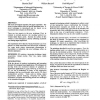Free Online Productivity Tools
i2Speak
i2Symbol
i2OCR
iTex2Img
iWeb2Print
iWeb2Shot
i2Type
iPdf2Split
iPdf2Merge
i2Bopomofo
i2Arabic
i2Style
i2Image
i2PDF
iLatex2Rtf
Sci2ools
89
Voted
CHI
1994
ACM
1994
ACM
The "silk cursor": investigating
This study investigates dynamic 3D target acquisition. The focus is on the relative effect of specific perceptual cues. A novel technique is introduced and we report on an experiment that evaluates its effectiveness. There are two aspects to the new technique. First, in contrast to normal practice, the tracking symbol is a volume rather than a point. Second, the surface of this volume is semi-transparent, thereby affording occlusion cues during target acquisition. The experiment shows that the volumehcclusion cues were effective in both monocular and stereoscopic conditions. For some tasks where stereoscopic presentation is unavailable or infeasible, the new techniaue offers an effective alternative.
CHI 1994 | Dynamic 3D Target | Human Computer Interaction | Specific Perceptual Cues | Target Acquisition |
| Added | 09 Aug 2010 |
| Updated | 09 Aug 2010 |
| Type | Conference |
| Year | 1994 |
| Where | CHI |
| Authors | Shumin Zhai, William Buxton, Paul Milgram |
Comments (0)

